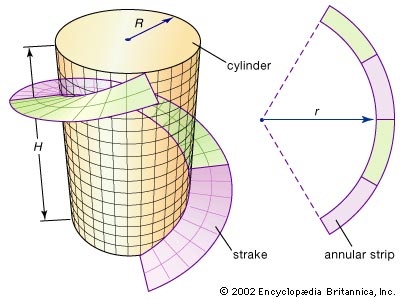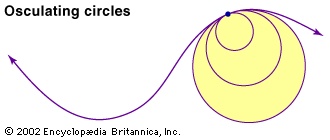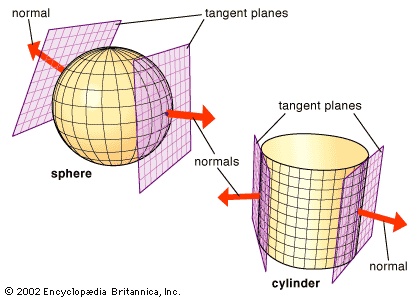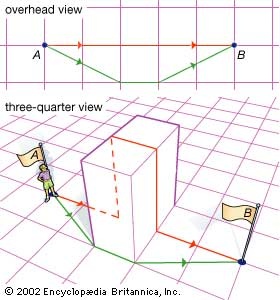differential geometry
Introduction
branch of mathematics that studies the geometry of curves, surfaces, and manifolds (manifold) (the higher-dimensional analogs of surfaces). The discipline owes its name to its use of ideas and techniques from differential calculus, though the modern subject often uses algebraic and purely geometric techniques instead. Although basic definitions, notations, and analytic descriptions vary widely, the following geometric questions prevail: How does one measure the curvature of a curve within a surface (intrinsic) versus within the encompassing space (extrinsic)? How can the curvature of a surface be measured? What is the shortest path within a surface between two points on the surface? How is the shortest path on a surface related to the concept of a straight line?
While curves had been studied since antiquity, the discovery of calculus in the 17th century opened up the study of more complicated plane curves—such as those produced by the French mathematician René Descartes (Descartes, René) (1596–1650) with his “compass” (see History of geometry: Cartesian geometry (geometry)). In particular, integral calculus led to general solutions of the ancient problems of finding the arc length of plane curves and the area of plane figures. This in turn opened the stage to the investigation of curves and surfaces in space—an investigation that was the start of differential geometry.
 Some of the fundamental ideas of differential geometry can be illustrated by the strake, a spiraling strip often designed by engineers to give structural support to large metal cylinders such as smokestacks. A strake can be formed by cutting an annular strip (the region between two concentric circles) from a flat sheet of steel and then bending it into a helix that spirals around the cylinder, as illustrated in the figure-->
Some of the fundamental ideas of differential geometry can be illustrated by the strake, a spiraling strip often designed by engineers to give structural support to large metal cylinders such as smokestacks. A strake can be formed by cutting an annular strip (the region between two concentric circles) from a flat sheet of steel and then bending it into a helix that spirals around the cylinder, as illustrated in the figure--> . What should the radius r of the annulus be to produce the best fit? Differential geometry supplies the solution to this problem by defining a precise measurement for the curvature of a curve; then r can be adjusted until the curvature of the inside edge of the annulus matches the curvature of the helix.
. What should the radius r of the annulus be to produce the best fit? Differential geometry supplies the solution to this problem by defining a precise measurement for the curvature of a curve; then r can be adjusted until the curvature of the inside edge of the annulus matches the curvature of the helix.An important question remains: Can the annular strip be bent, without stretching, so that it forms a strake around the cylinder? In particular, this means that distances measured along the surface (intrinsic) are unchanged. Two surfaces are said to be isometric if one can be bent (or transformed) into the other without changing intrinsic distances. (For example, because a sheet of paper can be rolled into a tube without stretching, the sheet and tube are “locally” isometric—only locally because new, and possibly shorter, routes are created by connecting the two edges of the paper.) Thus, the second question becomes: Are the annular strip and the strake isometric? To answer this and similar questions, differential geometry developed the notion of the curvature of a surface.
Curvature of curves
 Although mathematicians from antiquity had described some curves as curving more than others and straight lines as not curving at all, it was the German mathematician Gottfried Leibniz (Leibniz, Gottfried Wilhelm) who, in 1686, first defined the curvature of a curve at each point in terms of the circle that best approximates the curve at that point. Leibniz named his approximating circle (as shown in the figure-->
Although mathematicians from antiquity had described some curves as curving more than others and straight lines as not curving at all, it was the German mathematician Gottfried Leibniz (Leibniz, Gottfried Wilhelm) who, in 1686, first defined the curvature of a curve at each point in terms of the circle that best approximates the curve at that point. Leibniz named his approximating circle (as shown in the figure--> ) the osculating circle, from the Latin osculare (“to kiss”). He then defined the curvature of the curve (and the circle) as 1/r, where r is the radius of the osculating circle. As a curve becomes straighter, a circle with a larger radius must be used to approximate it, and so the resulting curvature decreases. In the limit, a straight line is said to be equivalent to a circle of infinite radius and its curvature defined as zero everywhere. The only curves in ordinary Euclidean space with constant curvature are straight lines, circles, and helices. In practice, curvature is found with a formula that gives the rate of change, or derivative, of the tangent to the curve as one moves along the curve. This formula was discovered by Isaac Newton (Newton, Sir Isaac) and Leibniz for plane curves in the 17th century and by the Swiss mathematician Leonhard Euler (Euler, Leonhard) for curves in space in the 18th century. (Note that the derivative of the tangent to the curve is not the same as the second derivative studied in calculus, which is the rate of change of the tangent to the curve as one moves along the x-axis.)
) the osculating circle, from the Latin osculare (“to kiss”). He then defined the curvature of the curve (and the circle) as 1/r, where r is the radius of the osculating circle. As a curve becomes straighter, a circle with a larger radius must be used to approximate it, and so the resulting curvature decreases. In the limit, a straight line is said to be equivalent to a circle of infinite radius and its curvature defined as zero everywhere. The only curves in ordinary Euclidean space with constant curvature are straight lines, circles, and helices. In practice, curvature is found with a formula that gives the rate of change, or derivative, of the tangent to the curve as one moves along the curve. This formula was discovered by Isaac Newton (Newton, Sir Isaac) and Leibniz for plane curves in the 17th century and by the Swiss mathematician Leonhard Euler (Euler, Leonhard) for curves in space in the 18th century. (Note that the derivative of the tangent to the curve is not the same as the second derivative studied in calculus, which is the rate of change of the tangent to the curve as one moves along the x-axis.) With these definitions in place, it is now possible to compute the ideal inner radius r of the annular strip that goes into making the strake shown in the figure-->
With these definitions in place, it is now possible to compute the ideal inner radius r of the annular strip that goes into making the strake shown in the figure--> . The annular strip's inner curvature 1/r must equal the curvature of the helix on the cylinder. If R is the radius of the cylinder and H is the height of one turn of the helix, then the curvature of the helix is 4π2R/【H2+(2πR)2】. For example, if R=1metre and H=10metres, then r=3.533metres.
. The annular strip's inner curvature 1/r must equal the curvature of the helix on the cylinder. If R is the radius of the cylinder and H is the height of one turn of the helix, then the curvature of the helix is 4π2R/【H2+(2πR)2】. For example, if R=1metre and H=10metres, then r=3.533metres.Curvature of surfaces
 To measure the curvature of a surface at a point, Euler, in 1760, looked at cross sections of the surface made by planes that contain the line perpendicular (or “normal”) to the surface at the point (see figure-->
To measure the curvature of a surface at a point, Euler, in 1760, looked at cross sections of the surface made by planes that contain the line perpendicular (or “normal”) to the surface at the point (see figure--> ). Euler called the curvatures of these cross sections the normal curvatures of the surface at the point. For example, on a right cylinder of radius r, the vertical cross sections are straight lines and thus have zero curvature; the horizontal cross sections are circles, which have curvature 1/r. The normal curvatures at a point on a surface are generally different in different directions. The maximum and minimum normal curvatures at a point on a surface are called the principal (normal) curvatures, and the directions in which these normal curvatures occur are called the principal directions. Euler proved that for most surfaces where the normal curvatures are not constant (for example, the cylinder), these principal directions are perpendicular to each other. (Note that on a sphere all the normal curvatures are the same and thus all are principal curvatures.) These principal normal curvatures are a measure of how “curvy” the surface is.
). Euler called the curvatures of these cross sections the normal curvatures of the surface at the point. For example, on a right cylinder of radius r, the vertical cross sections are straight lines and thus have zero curvature; the horizontal cross sections are circles, which have curvature 1/r. The normal curvatures at a point on a surface are generally different in different directions. The maximum and minimum normal curvatures at a point on a surface are called the principal (normal) curvatures, and the directions in which these normal curvatures occur are called the principal directions. Euler proved that for most surfaces where the normal curvatures are not constant (for example, the cylinder), these principal directions are perpendicular to each other. (Note that on a sphere all the normal curvatures are the same and thus all are principal curvatures.) These principal normal curvatures are a measure of how “curvy” the surface is.The theory of surfaces and principal normal curvatures was extensively developed by French geometers led by Gaspard Monge (Monge, Gaspard, comte de Péluse) (1746–1818). It was in an 1827 paper, however, that the German mathematician Carl Friedrich Gauss (Gauss, Carl Friedrich) made the big breakthrough that allowed differential geometry to answer the question raised above of whether the annular strip is isometric to the strake. The Gaussian curvature of a surface at a point is defined as the product of the two principal normal curvatures; it is said to be positive if the principal normal curvatures curve in the same direction and negative if they curve in opposite directions. Normal curvatures for a plane surface are all zero, and thus the Gaussian curvature of a plane is zero. For a cylinder of radius r, the minimum normal curvature is zero (along the vertical straight lines), and the maximum is 1/r (along the horizontal circles). Thus, the Gaussian curvature of a cylinder is also zero.
If the cylinder is cut along one of the vertical straight lines, the resulting surface can be flattened (without stretching) onto a rectangle. In differential geometry, it is said that the plane and cylinder are locally isometric. These are special cases of two important theorems:
● Gauss's “Remarkable Theorem” (1827). If two smooth surfaces are isometric, then the two surfaces have the same Gaussian curvature at corresponding points. (Athough defined extrinsically, Gaussian curvature is an intrinsic notion.)
● Minding's theorem (1839). Two smooth (“cornerless”) surfaces with the same constant Gaussian curvature are locally isometric.
As corollaries to these theorems:
● A surface with constant positive Gaussian curvature c has locally the same intrinsic geometry as a sphere of radius √1/c. (This is because a sphere of radius r has Gaussian curvature 1/r2).
● A surface with constant zero Gaussian curvature has locally the same intrinsic geometry as a plane. (Such surfaces are called developable).
● A surface with constant negative Gaussian curvature c has locally the same intrinsic geometry as a hyperbolic plane. (See non-Euclidean geometry.)
The Gaussian curvature of an annular strip (being in the plane) is constantly zero. So to answer whether or not the annular strip is isometric to the strake, one needs only to check whether a strake has constant zero Gaussian curvature. The Gaussian curvature of a strake is actually negative, hence the annular strip must be stretched—although this can be minimized by narrowing the shapes.
Shortest paths on a surface
From an outside, or extrinsic, perspective, no curve on a sphere is straight. Nevertheless, the great circles are intrinsically straight—an ant crawling along a great circle does not turn or curve with respect to the surface. About 1830 the Estonian mathematician Ferdinand Minding defined a curve on a surface to be a geodesic if it is intrinsically straight—that is, if there is no identifiable curvature from within the surface. A major task of differential geometry is to determine the geodesics on a surface. The great circles are the geodesics on a sphere.
 A great circle arc that is longer than a half circle is intrinsically straight on the sphere, but it is not the shortest distance between its endpoints. On the other hand, the shortest path in a surface is not always straight, as shown in the figure-->
A great circle arc that is longer than a half circle is intrinsically straight on the sphere, but it is not the shortest distance between its endpoints. On the other hand, the shortest path in a surface is not always straight, as shown in the figure--> . An important theorem is:
. An important theorem is:On a surface which is complete (every geodesic can be extended indefinitely) and smooth, every shortest curve is intrinsically straight and every intrinsically straight curve is the shortest curve between nearby points.
Additional Reading
Visualizing curves and surfaces
James Casey, Exploring Curvature (1996), is a truly delightful book full of “experiments” to explore the curvature of curves and surfaces. Jeffrey R. Weeks, The Shape of Space: How to Visualize Surfaces and Three-Dimensional Manifolds (1985), contains an elementary but deep discussion of different two- and three-dimensional spaces that may be models for the shape of our physical universe. Alfred Gray, Modern Differential Geometry of Curves and Surfaces with Mathematica, 2nd ed. (1998), allows exploration of the subject through computer-generated figures. Vladimir Rovenski, Geometry of Curves and Surfaces with MAPLE (2000), is another textbook-software package for exploring differential geometry.
Introductory textbooks
David W. Henderson, Differential Geometry: A Geometric Introduction (1998), emphasizes the underlying geometric intuitions, rather than analytic formalisms. John McCleary, Geometry from a Differentiable Viewpoint (1994), emphasizes the history of the subject from Euclid's fifth (“parallel”) postulate and the development of the hyperbolic plane through the genesis of differential geometry. Richard S. Millman and George D. Parker, Elements of Differential Geometry (1977), uses linear algebra extensively to treat the formalisms of extrinsic differential geometry. Saul Stahl, The Poincaré Half-Plane: A Gateway to Modern Geometry (1993), is an analytic introduction to some of the ideas of intrinsic differential geometry starting from calculus. Ethan D. Bloch, A First Course in Geometric Topology and Differential Geometry (1997), explores the notion of curvature on polyhedra and contains the topological classification and differential geometry of surfaces.
- Kumamoto
- Kumanovo
- Kumarajiva
- Kumaraswami Kamaraj
- Kumaratunga, Chandrika Bandaranaike
- Kumasi
- Kumazawa Banzan
- Kumba
- Kumbakonam
- Kumbh Mela
- Kumbi
- Kume Masao
- Kumi
- Kumin, Maxine
- Kummer, Ernst Eduard
- Kumo
- kumquat
- Kumārila
- kun
- Kuna
- Kunama languages
- Kun, Béla
- Kuncewiczowa, Maria
- Kunckel von Löwenstjern, Johann
- Kundera, Milan